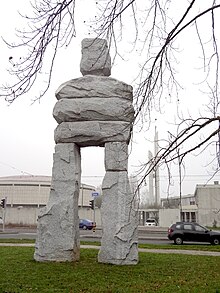


Ugo Rondinone (born 1964) is a New York-based, Swiss-born mixed-media artist noted for a range of contemporary paintings and sculptures.
Rondinone is widely known for his temporary, large-scale land art sculpture, Seven Magic Mountains (2016-2018), with its seven fluorescently-painted totems of large, car-size stones stacked 32 feet (9.8 m) high.[1][2] The installation's organizer, the Nevada Museum of Art, estimated that 16 million people would see the work — from its location just south of Las Vegas, alongside Interstate 15, the primary Los Angeles-Las Vegas interstate.[3]
Life and Works
editUgo Rondinone was born in 1964 to Italian parents in the resort town of Brunnen, Switzerland. He moved to Zurich in 1983 to become the assistant to Hermann Nitsch and studied at the Hochschule für angewandte Kunst in Wien, from 1986 to 1990. In 1998 he moved to New York City, where he continues to live and work in Harlem.[4]
Rondinone emerged as an artist in the 1990s.[5] Rondinone's paintings are noted for their brightly colored, concentric rings of target-shapes;[6] strictly black and white landscapes of gnarled trees;[7] and large rainbow signs.[8]
In 2013 he exhibited an installation called Human Nature, a group of monumental stone figures in Rockefeller Center, Manhattan — resembling rudimentary rock totems.[9]
Seven Magic Mountains (2016-2018)
editSeven Magic Mountains followed Rondinone's work Human Nature, a Public Art Fund project of monumental, stone stick-figures arranged in the highly man-made environment of Rockefeller Center in Manhattan — and depicts the opposite: highly artificial neon totems set in the natural environment.[3]
The piece consists of 33 limestone boulders, each weighing 10 to 25 tons, arranged in seven towers 30 to 35 feet tall[10] — secured by a solid backbone, with each stone painted a bright, fluorescent color.[3] Approximately five years in the making, the work is located on the far southern end of Las Vegas Boulevard,[11] 10 miles south of the intersection of Las Vegas Boulevard and St. Rose Parkway in Henderson, Nevada — near Dry Jean Lake, with a backdrop of the McCullough Mountains.[12]
- See Location, Seven Magic Mountains: 35°50′18.19″N 115°16′15.304″W / 35.8383861°N 115.27091778°W
The sculpture was organized by the Nevada Museum of Art[3] and runs from May 11, 2016 to December 31, 2018[11] — having originally been scheduled for two years and extended through the end of 2018.[10] The installation opened following a two-day inaugural event.[13]
The work is situated on three acres of federally owned land[12] under the jurisdiction of the Bureau of Land Management.[12] Resolving federal, state, and local regulations consummed nearly 20% of the project’s budget[12] and permitting took approximately three years.[12] Ultimately, the Bureau of Land Management granted a “site” type right-of-way permit — typically a 30-year permit authorizing projects such as communication towers —for three years.[12] Seven Magic Mountains was privately funded and cost approximately $3.5 million.[10]
A special law reduces the producers’ and the artist’s liability if a member of the viewing public "does something stupid" (e.g., climbing and falling).[3] The law, Seven Magic Mountains, NRS 41.517, is the only public-art carve-out in the country.[12] Signs around the sculpture warn viewers of potential dangers.[3]
The Reno Gazette-Journal estimated that more than 2 million people have taken photographs at the sculpture for Instagram. Vogue used the installation in a photo shoot in April 2017.[10] It is one of the largest land-based art installations in the United States since the early 1990s.[11]
Exhibitions
editThis article needs additional citations for verification. (August 2018) |
He has been the subject of major solo exhibitions at the Kunsthalle, Vienna; Museo de Art Contemporaneo, Leon, Spain; Louisiana Museum of Modern Art, Humlebaek, Denmark; Contemporary Arts Center, Cincinnati, Ohio; and Sculpture Center, New York. In 2007, he represented Switzerland in the Venice Biennale. His works are in the collections of the New Museum of Contemporary Art, New York, among others.
See also
editReferences
edit- ^ "Ugo Rondinone's Magic Mountains Bring Color to the Nevada Desert". Format Magazine. Retrieved 19 September 2016.
- ^ Graham Bowley (April 9, 2015), Splash of color in the desert New York Times
- ^ a b c d e f Andrew Russeth (May 31, 2016). "This Magic Moment: Ugo Rondinone Places Seven Mountains in the Desert Outside Las Vegas". Art News.
- ^ Ugo Rondinone Biography, Galerie Eva Presenhuber, retrieved 04.04.2015
- ^ Ugo Rondinone Biography, New Media Encyclopedia, retrieved 04.04.2015
- ^ Ugo Rondinone 'Post-History Painting', Pomeranz Collection
- ^ Ugo Rondinone, 'Temporary Contemporary', Bass Museum of Art
- ^ "Ugo Rondinone - Works - Gladstone Gallery". gladstonegallery.com. Gladstone Gallery. Retrieved 2 November 2018.
- ^ Scobie, Ilka (9 May 2013). "Ugo Rondinone: Human Nature at Rockefeller Center - artcritical". artcritical. artcritical. Retrieved 2 November 2018.
- ^ a b c d Dawn Cate (June 1, 2018). "'Seven Magic Mountains' near Las Vegas is an Instagram dream". The Tampa Bay Times.
- ^ a b c "ugo rondinone seven magic mountains". Nevadaart.org.
- ^ a b c d e f g Isaac Kaplan (Apr 14, 2017). "How Artistry, Bureaucracy, and Lobbying Combined to Create a $3.5 Million Public Sculpture in the Desert". Artsy.net.
- ^ Rebecca Kleinman (May 11, 2016). "The Story Behind Las Vegas' 'Seven Magic Mountains' Desert Art". Art News.
External links
edit- Ugo Rondinone Human Nature at Rockefeller Center organized by Public Art Fund
- Ugo Rondinone's 2005-06 sculptures in Pappajohn Sculpture Park, Greater Des Moines Public Art Foundation in Iowa
- Ugo Rondinone Extended Biog and Exhibition information
- Art review by Joseph Nechvatal of Ugo Rondinone's THE THIRD MIND at Le Palais de Tokyo, Paris
- 'if there were anywhere but desert, Wednesday'[1] Kaldor Family Collection, Art Gallery of NSW
- Ugo Rondinone Artist Page at Sommer Contemporary Art Gallery Website
Category:Artists from New York (state)
Category:Swiss contemporary artists
Category:Swiss artists
Category:Living people
Category:1964 births
Category:Outdoor sculptures in Nevada
Category:Buildings and structures in Nevada
Category:Roadside attractions